Unsteady Simulation of a Full-Scale CANDU-6 Moderator with OpenFOAM
Abstract
:1. Introduction
2. Simulation Method
2.1. Open Source Code
2.2. Governing Equations and Discretization
2.3. Boundary and Initial Conditions
- Velocities: no-slip conditions at walls, and the mass flow rate is specified on the inlet, fixed to 127.4 kg/s per each inlet nozzle, or 1019 kg/s in total for the present problem. The inlet turbulent intensity is fixed as 5%, which can make the additional uncertainty for the turbulent flow linked with the full system;
- Pressure: zero pressure gradient conditions at walls and inlet, which should be valid under the assumption that the thickness of boundary layer is very thin. The outlet pressure is fixed by the moderator system;
- Temperature: the inlet temperature is fixed to 47.3 °C.
2.4. Grid Generation
3. Result and Discussion
3.1. Quasi-Steady State
3.2. Turbulent Model and Scale
3.3. Velocity and Temperature Fields in the Unsteady Solution
3.4. Validation of Numerical Data
4. Conclusions
Author Contributions
Funding
Conflicts of Interest
References
- Wolsong Units. 2/3/4 Final Safety Analysis Report; Korea Electric Power Corporation: Naju, Korea, 1995; Chapter 15. [Google Scholar]
- Gillespie, G.E. An Experimental Investigation of Heat Transfer from a Reactor Fuel Channel: To Surrounding Water. In Proceedings of the 2nd Annual Conf. Canadian Nuclear Society, Ottawa, ON, Canada, 10 June 1981. [Google Scholar]
- Fan, H.Z.; Aboud, R.; Neal, P.; Nitheanandan, T. Enhancement of the Moderator Subcooling Margin using Glass-peened Calandria Tubes in CANDU Reactors. In Proceedings of the 30th Annual Conference of the Canadian Nuclear Society, Calgary, AB, Canada, 31 May–3 June 2009. [Google Scholar]
- Huget, R.G.; Szymanski, J.; Midvidy, W. Status of Physical and Numerical Modelling of CANDU Moderator Circulation. In Proceedings of the 10th Annual Conference of the Canadian Nuclear Society, Ottawa, ON, Canada, 4–7 June 1989. [Google Scholar]
- Huget, R.G.; Szymanski, J.; Galpin, P.F.; Midvidy, W.I. MODTURC-CLAS: An Efficient Code for Analyses of Moderator Circulation in CANDU Reactors. In Proceedings of the 3rd International Conference on Simulation Methods in Nuclear Engineering, Montreal, QC, Canada, 18–20 April 1990. [Google Scholar]
- Khartabil, H.F.; Inch, W.W.; Szymanski, J.; Novog, D.; Tavasoli, V.; Mackinnon, J. Three-dimensional moderator circulation experimental program for validation of CFD code MODTURC_CLAS. In Proceedings of the 21th CNS Nuclear Simulation Symposium, Ottawa, ON, Canada, 24–26 September 2000. [Google Scholar]
- Kim, H.T.; Rhee, B.W. Scaled-down moderator circulation test facility at Korea Atomic Energy Research Institute. Sci. Technol. Nucl. Install. 2016, 2016, 5903602. [Google Scholar] [CrossRef]
- Im, S.; Kim, H.T.; Rhee, B.W.; Sung, H.J. PIV measurement of the flow patterns in a CANDU-6 model. Ann. Nucl. Eng. 2016, 98, 1–11. [Google Scholar] [CrossRef]
- Hadaller, G.I.; Fortman, R.A.; Szymanski, J.; Midvidy, W.I.; Train, D.J. Frictional Pressure Drop for Staggered and In Line Tube Bank with Large Pitch to Diameter Ratio. In Proceedings of the 17th Annual Conference of the Canadian Nuclear Society, Fredericton, NB, Canada, 9–12 June 1996. [Google Scholar]
- Yoon, C. Development of a CFD Model for the CANDU-6 Moderator Analysis Using a Coupled Solver. Ann. Nucl. Eng. 2007, 35, 1041–1049. [Google Scholar] [CrossRef]
- Sarchami, A.; Ashgriz, N.; Kwee, M. Three Dimensional Numerical Simulation of a Full Scale CANDU Reactor Moderator to Study Temperature Fluctuations. Int. J. Eng. Phys. Sci. 2012, 6, 275–281. [Google Scholar] [CrossRef]
- Teyssedou, A.; Necciari, R.; Reggio, M.; Zadeh, F.M.; Étienne, S. Moderator Flow Simulation around Calandria Tubes of CANDU-6 Nuclear Reactors. Eng. Appl. Comput. Fluid Mech. 2014, 8, 178–192. [Google Scholar] [CrossRef]
- Gim, G.H.; Chang, S.M.; Lee, S.; Jang, G. Fluid-Structure Interaction in a U-Tube with Surface Roughness and Pressure Drop. Nucl. Eng. Technol. 2014, 46, 633–640. [Google Scholar] [CrossRef]
- Kim, H.T.; Chang, S.M. Computational Fluid Dynamics Analysis of the Canadian Deuterium Uranium Moderator Tests at the Stern Laboratories Inc. Nucl. Eng. Technol. 2015, 47, 284–292. [Google Scholar] [CrossRef]
- OpenFOAM User Guide; CFD Direct Ltd.: 2019. Available online: https://openfoam.com/documentation/user-guide/ (accessed on 20 January 2019).
- Kim, H.; Chang, S.M.; Shin, J.H.; Kim, Y.G. The Feasibility of Multidimensional CFD Applied to Calandria System in the Moderator of CANDU-6 PHWR Using Commercial and Open-Source Codes. Sci. Technol. Nucl. Install. 2016, 2016, 3194839. [Google Scholar] [CrossRef]
- Hanna, B.N. CATHENA: A thermalhydraulic code for CANDU analysis. Nucl. Eng. Des. 1998, 180, 113–131. [Google Scholar] [CrossRef]
- Seo, Y.S.; Chang, S.M.; Yeom, G.S. CFD Analysis on the Validation Experiment with MCT 1/4 Model; KAERI Report; Mirae Engineering Co.: Jeonju, Jeonbuk, Korea, 2015. [Google Scholar]
- Kim, H.T.; Chang, S.M. OpenFOAM Analysis of CANDU-6 Moderator Flow. In Proceedings of the Transactions of the Korean Nuclear Society Autumn Meeting, Gyeongju, Korea, 29–30 October 2015. [Google Scholar]
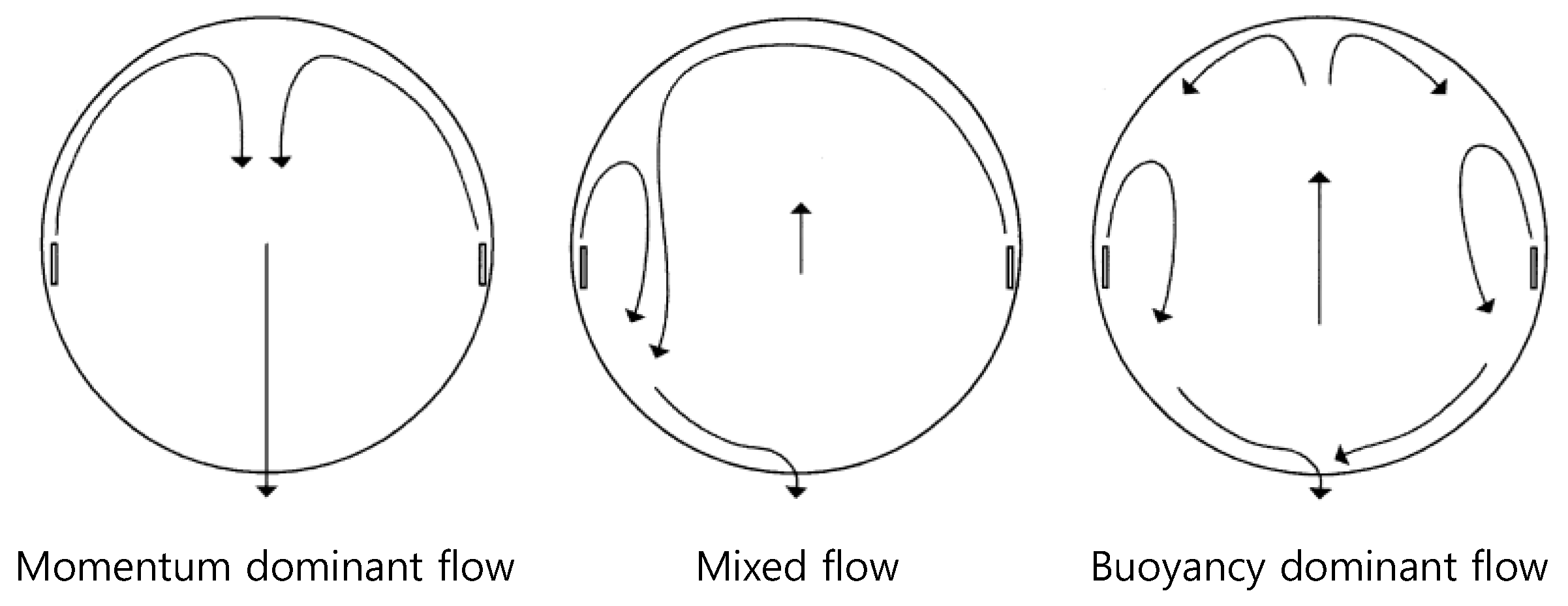

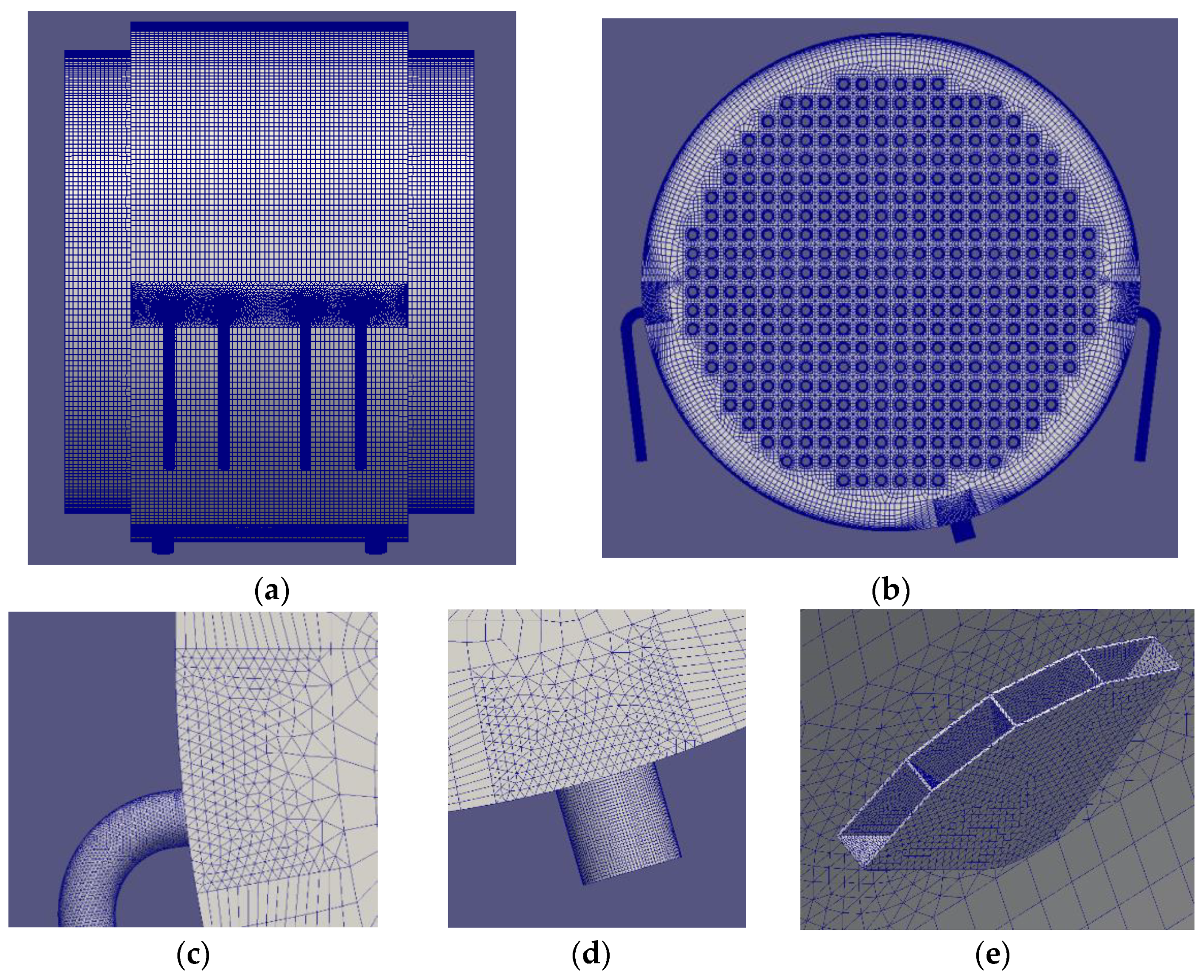
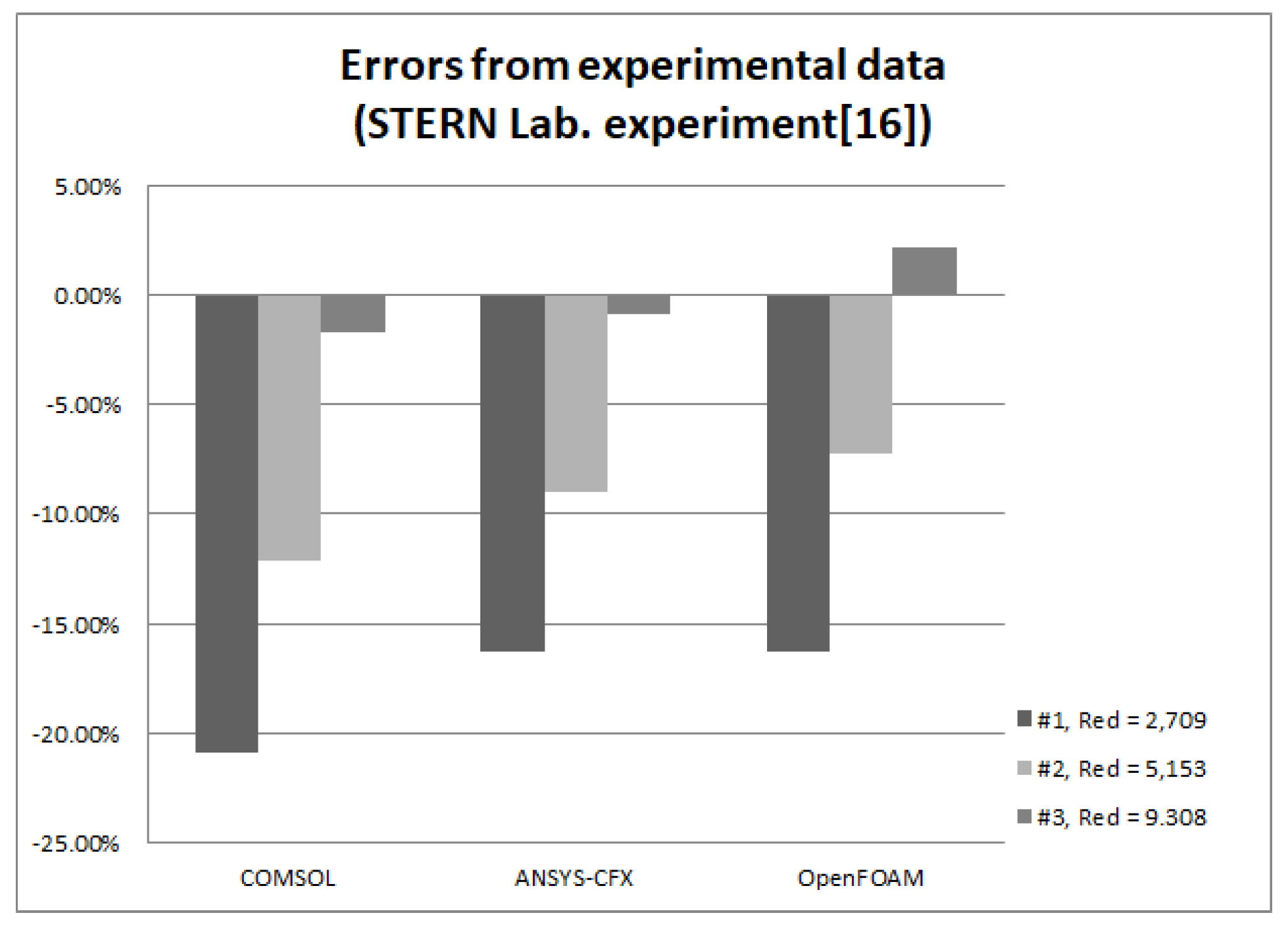

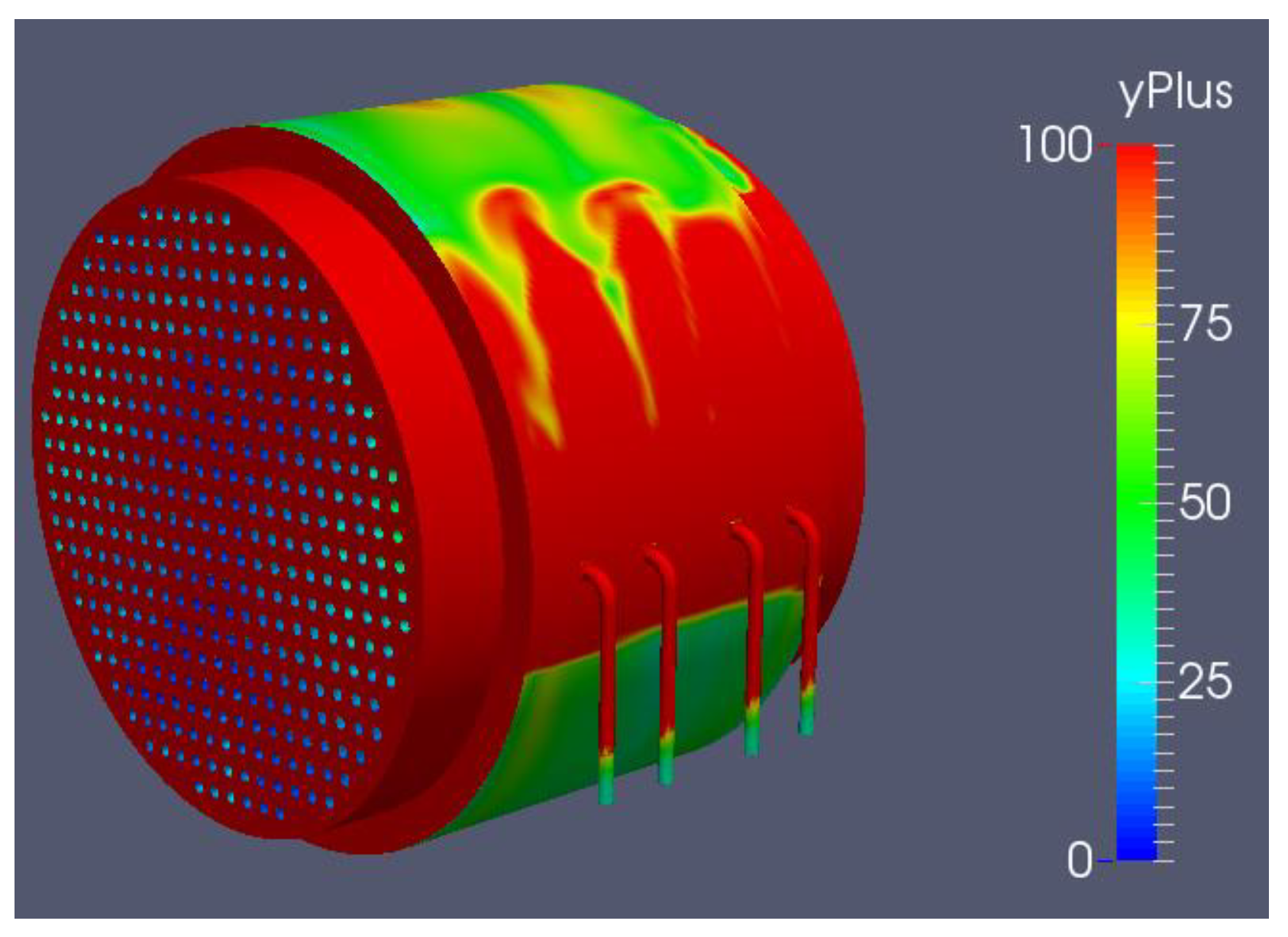

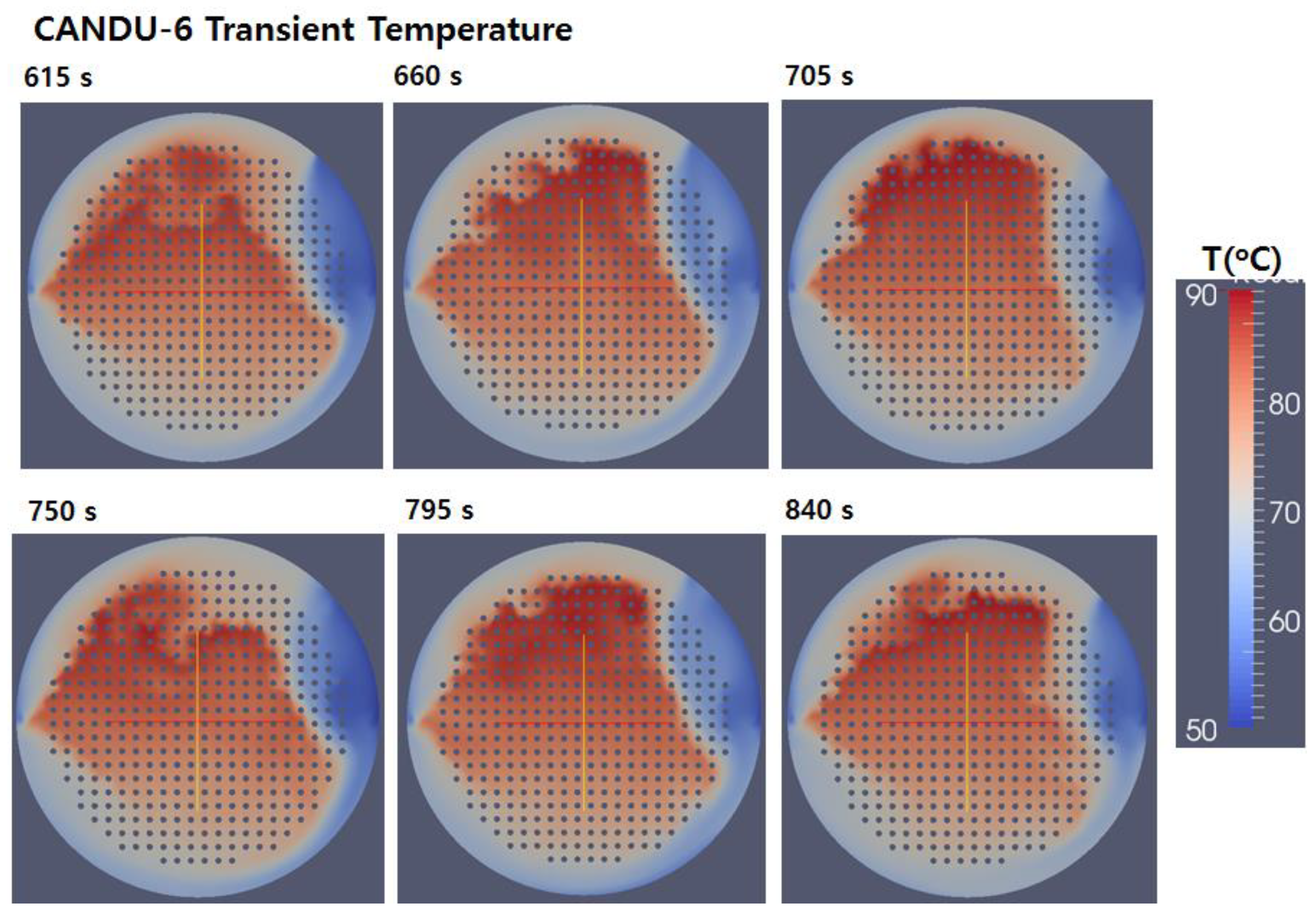
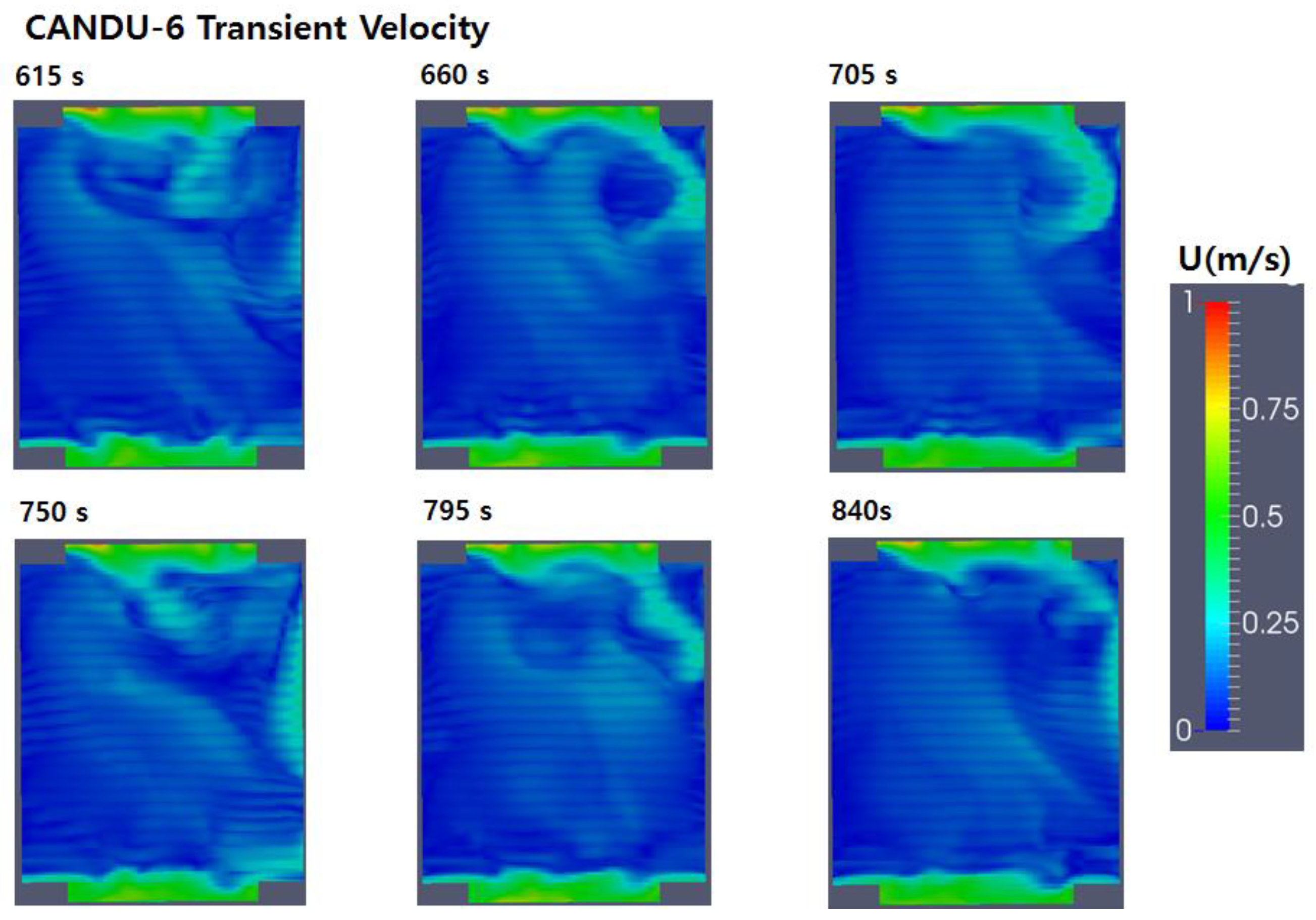
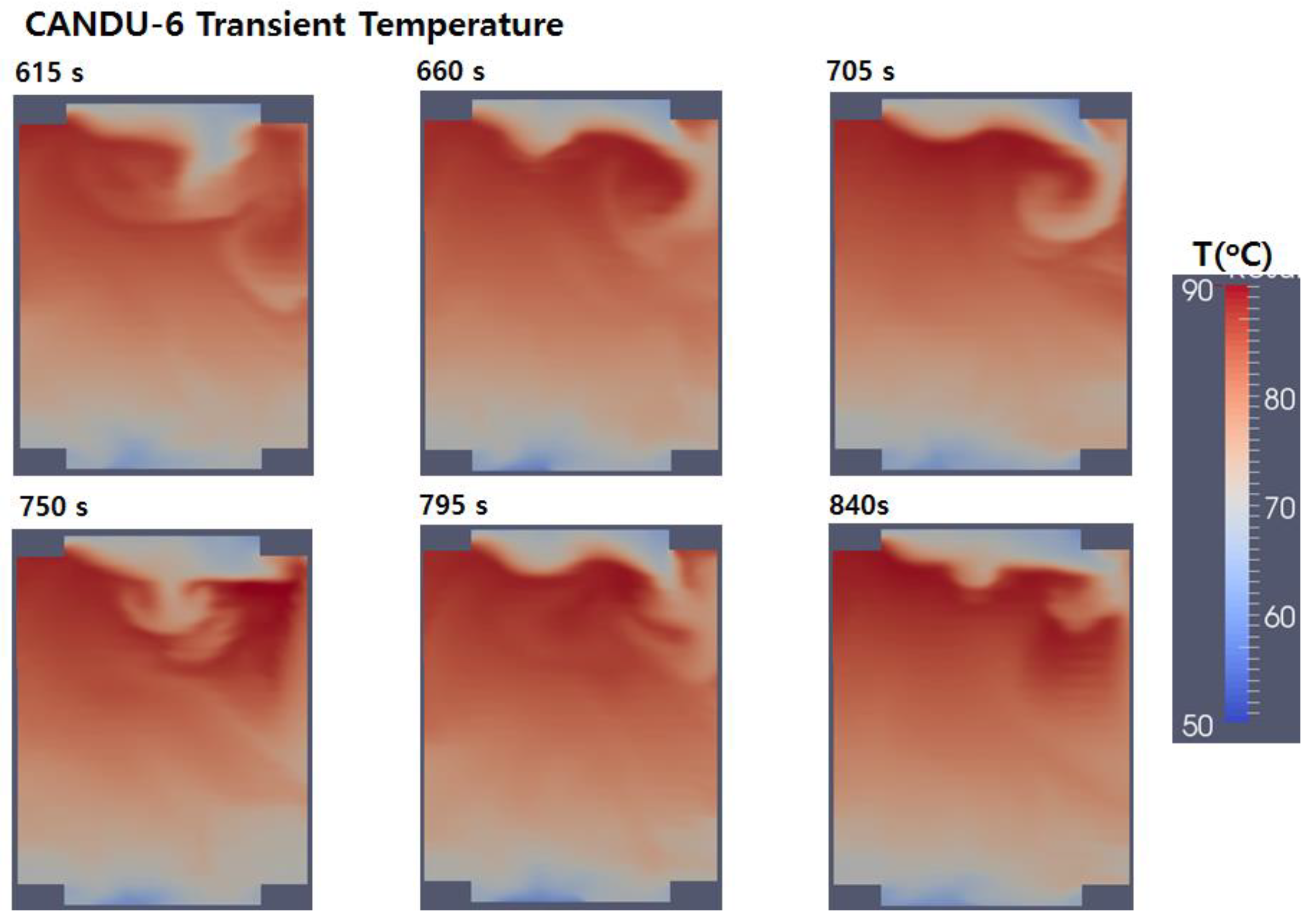
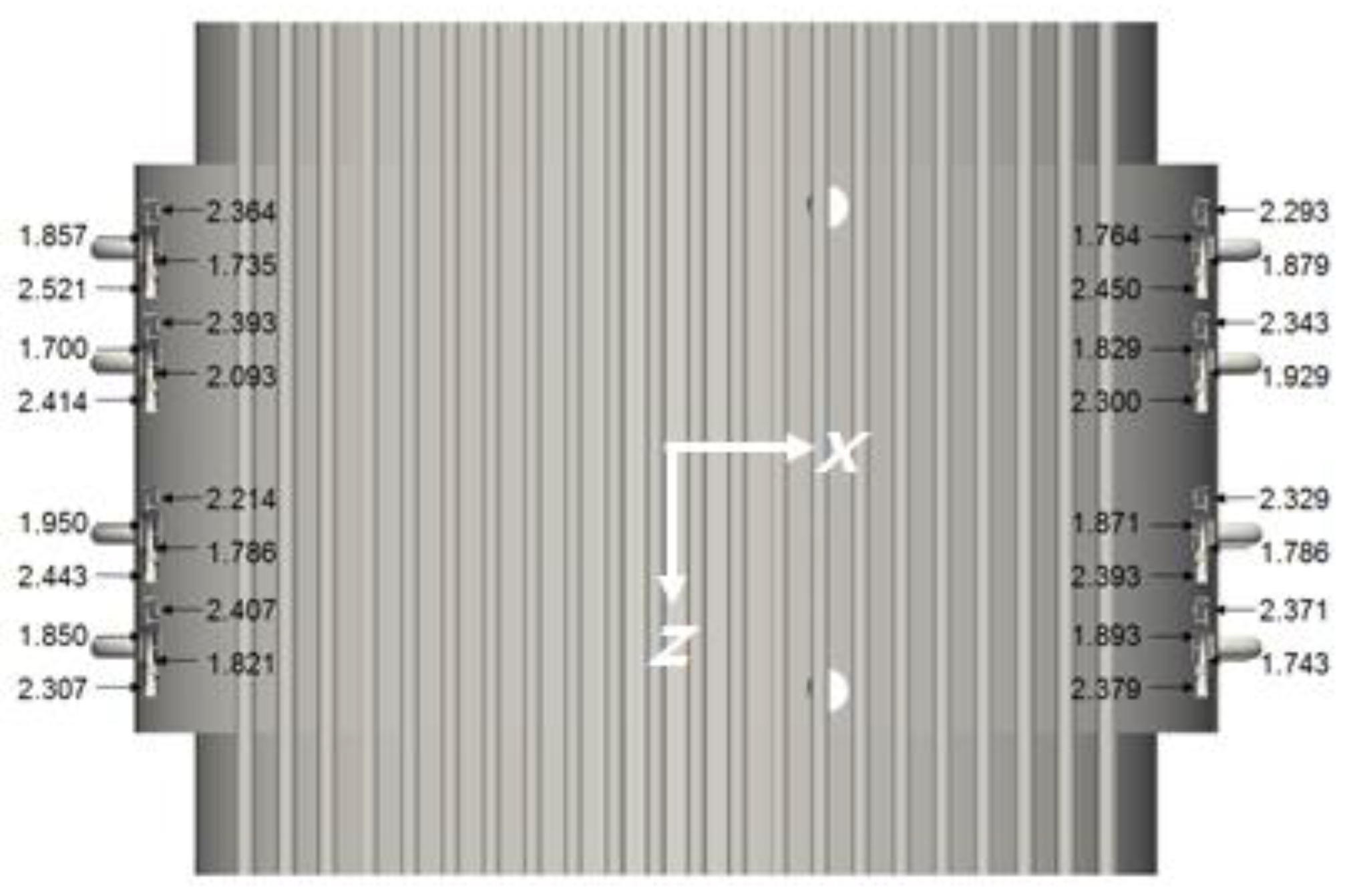
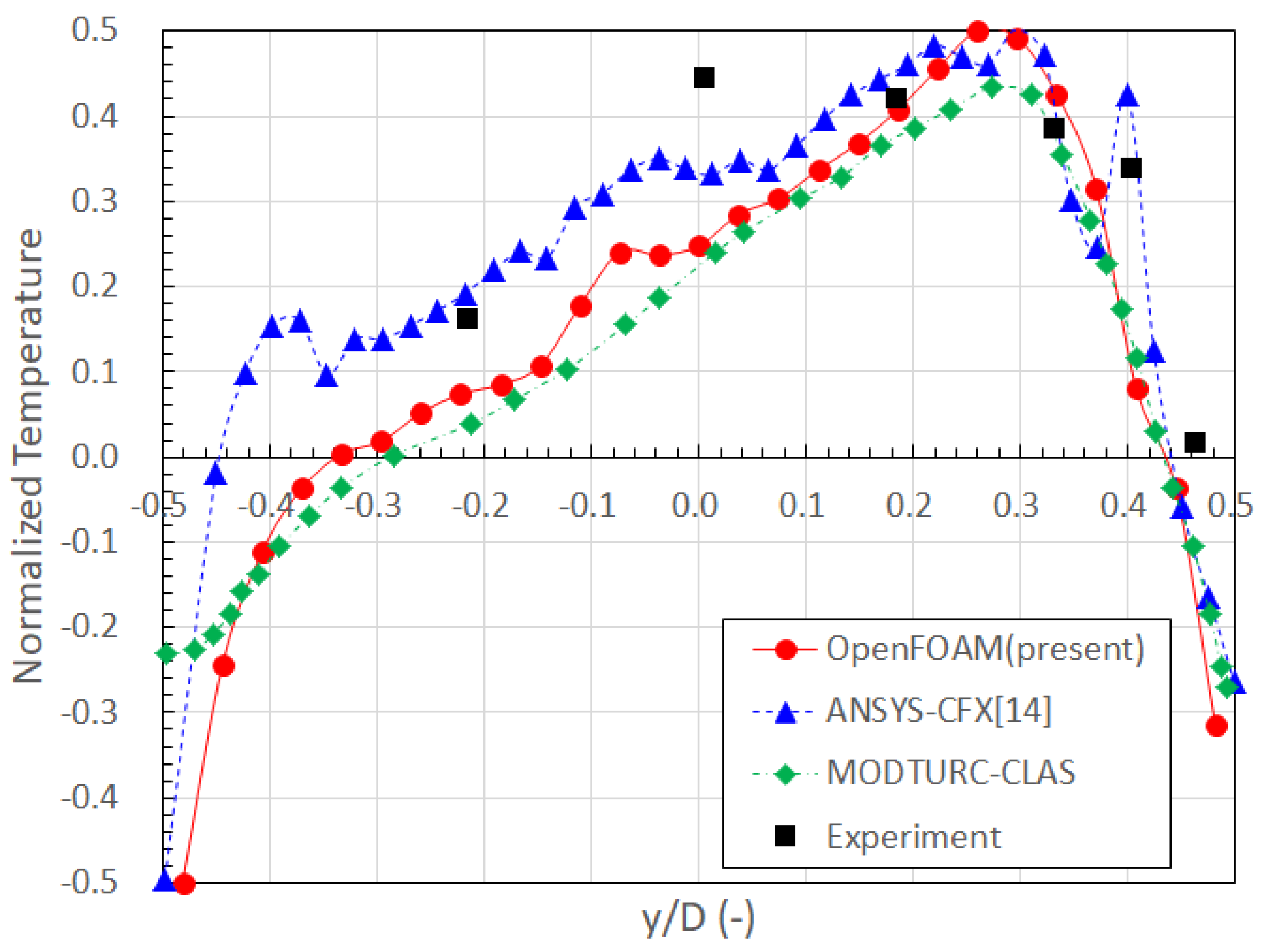
| Definition (Symbol) | Symbol | Value | Unit |
|---|---|---|---|
| Density | 1085 | kg/m3 | |
| Thermal expansion | β | 5 × 10−4 | K−1 |
| Dynamic viscosity | μ | 5.5 × 10−4 | kg/(m·s) |
| Heat Capacity | 4207 | J/(kg·K) | |
| Thermal conductivity | λ | 0.659 | W/(m·K) |
© 2019 by the authors. Licensee MDPI, Basel, Switzerland. This article is an open access article distributed under the terms and conditions of the Creative Commons Attribution (CC BY) license (http://creativecommons.org/licenses/by/4.0/).
Share and Cite
Kim, H.T.; Chang, S.-M.; Son, Y.W. Unsteady Simulation of a Full-Scale CANDU-6 Moderator with OpenFOAM. Energies 2019, 12, 330. https://doi.org/10.3390/en12020330
Kim HT, Chang S-M, Son YW. Unsteady Simulation of a Full-Scale CANDU-6 Moderator with OpenFOAM. Energies. 2019; 12(2):330. https://doi.org/10.3390/en12020330
Chicago/Turabian StyleKim, Hyoung Tae, Se-Myong Chang, and Young Woo Son. 2019. "Unsteady Simulation of a Full-Scale CANDU-6 Moderator with OpenFOAM" Energies 12, no. 2: 330. https://doi.org/10.3390/en12020330
APA StyleKim, H. T., Chang, S.-M., & Son, Y. W. (2019). Unsteady Simulation of a Full-Scale CANDU-6 Moderator with OpenFOAM. Energies, 12(2), 330. https://doi.org/10.3390/en12020330




